This Israeli or Pearl Couscous Salad with roasted asparagus and chickpeas is the perfect side dish for summer picnics, parties, BBQs and meal prep! The lemon olive oil dressing adds a refreshing burst of flavour that makes it a definite crowd pleaser! It can be made in less than 30 minutes! (Vegetarian)
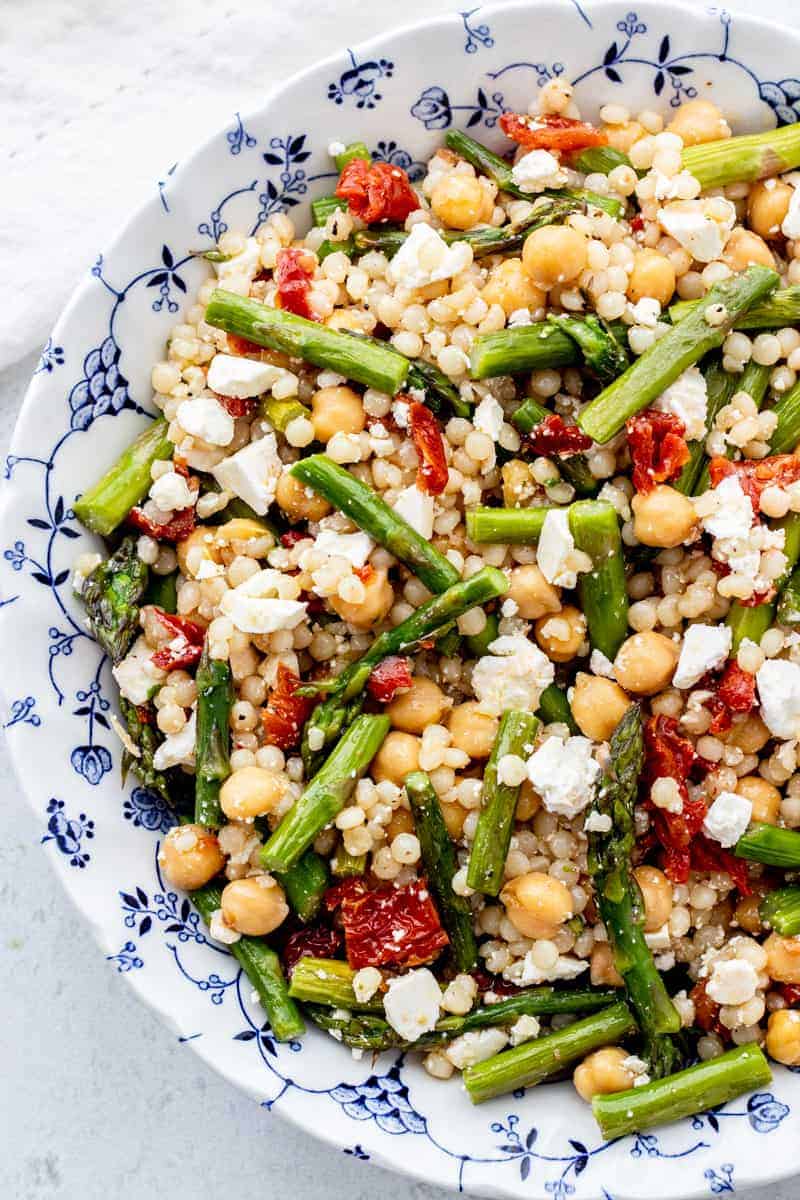
As the weather starts to get warmer, our family always starts to crave those refreshing salads, and this pearl couscous salad recipe is a definite winner! The kids love this one too!
Great to serve as a a side dish, this Israeli couscous is also great for meal prep and easy to turn into a full meal. Loaded with roasted asparagus, chickpeas, feta and sun-dried tomatoes and tossed in a vibrant lemon olive oil dressing, every bite is bursting with flavour and it’s perfect to enjoy throughout the spring and summer.
If you love this salad recipe, be sure to also try out my Asparagus Tomato Salad and Healthy Pasta Salad recipes too! Or for other Israeli couscous recipes, check out this Lemon Chicken Soup.
Table of Contents
Why Make this Recipe
- Make-ahead: This couscous salad is a great make ahead option if you’re planning to serve it as part of a larger meal. It’s also great for meal prep and travels well for picnics and pot lucks, since it tends to taste better the longer that it sits.
- Heart healthy: The fibre from the chickpeas and asparagus and the healthy fats from the olive oil make this the perfect heart healthy vegetarian salad option. You can make it completely plant-based by omitting the feta cheese and swapping the honey for maple syrup.
- Satisfying: This is a really hearty salad that’s full of fibre, protein and healthy fats, which makes it super filling. Perfect as a simple side dish, but can also be served as a main.
Ingredient Notes
For the couscous salad
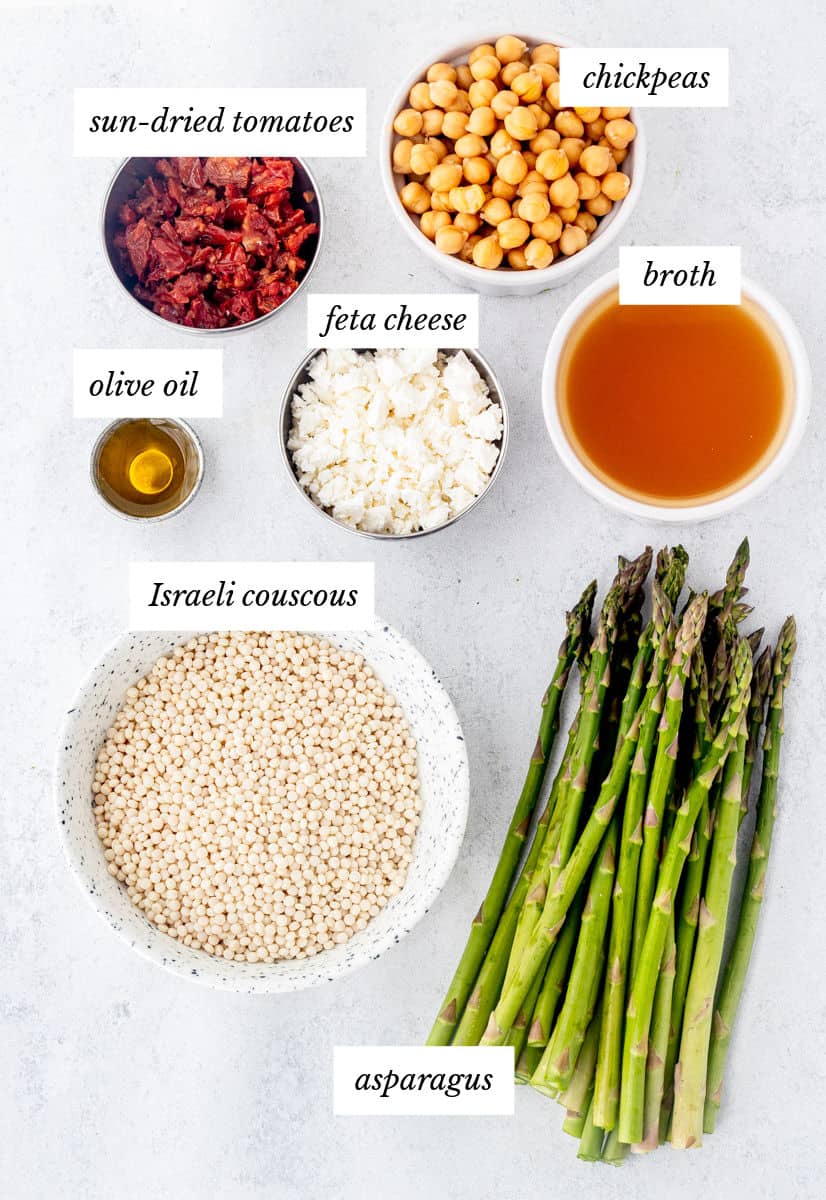
- Asparagus: Asparagus is a great source of vitamins A, C and K, and I love the fresh pop of colour that it adds to this dish. I recommend using asparagus of a medium thickness. You could easily swap in other vegetables as well such as cucumber, artichoke hearts or zucchini.
- Israeli Couscous: I love the taste and texture of the larger pearl couscous since it resembles a small pasta. You could also sub in regular couscous or quinoa if preferred.
- Broth: Cooking the couscous in the broth infuses some extra flavour into it. You can use chicken or vegetable broth in this recipe.
- Feta: This Greek cheese adds a great tangy flavour to each bite. You can use light or full-fat or sub in goat cheese to switch up the flavour profile.
- Chickpeas: Chickpeas are rich in fibre and protein and will help keep you feeling full and satisfied. I used no salt-added canned chickpeas for convenience, but you could also cook the chickpeas from scratch.
- Sun-Dried Tomatoes: These are optional, but I love the burst of flavour and the extra pop of colour they add to the salad. You could also sub in cherry tomatoes or roasted red peppers.
For the lemon dressing
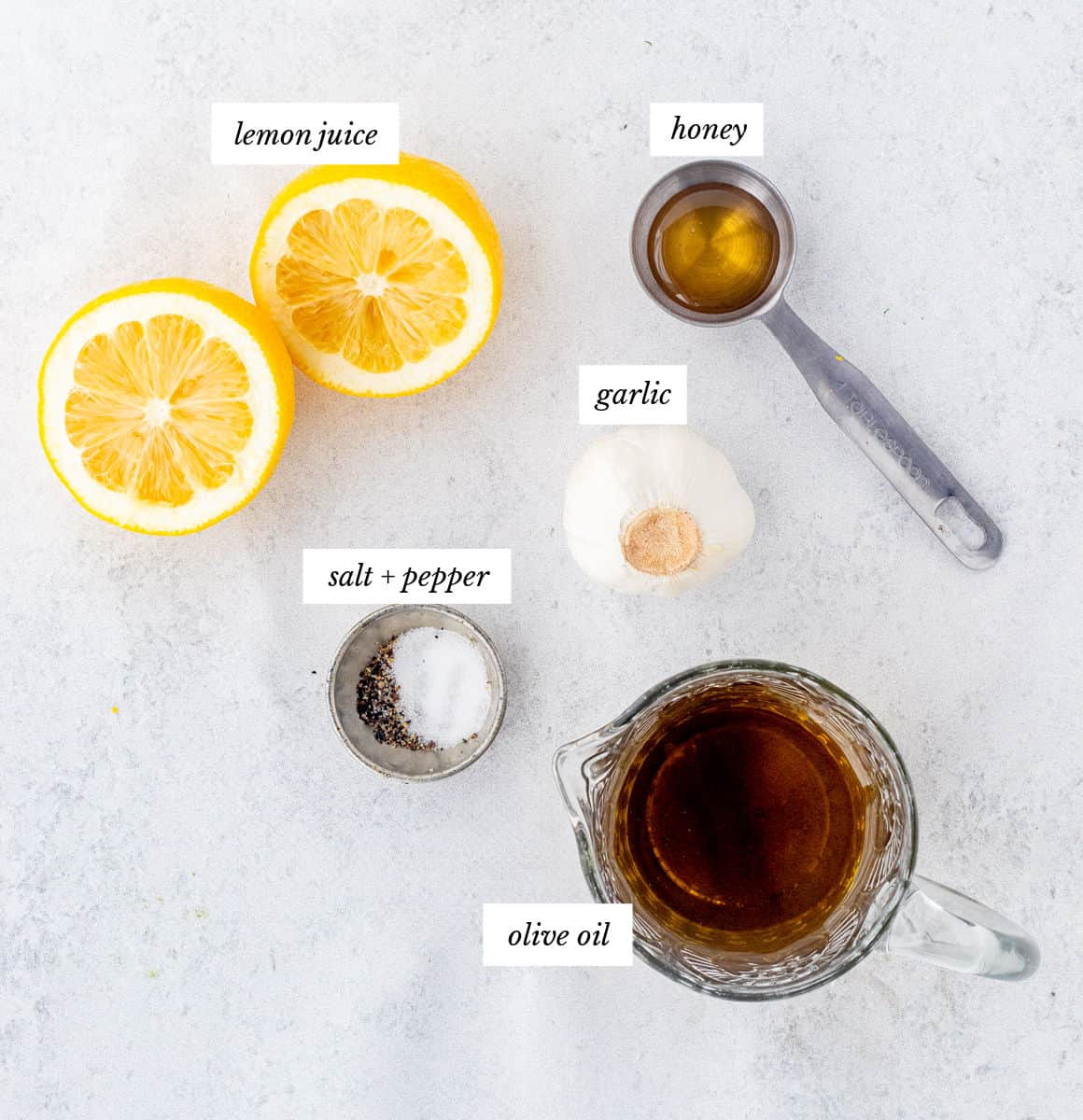
- Lemon Juice: Use fresh rather than bottled lemon juice for the brightest flavour.
- Garlic: Use freshly minced garlic for best results. You could also sub in garlic paste if in a pinch.
- Oil: I prefer using extra virgin olive oil in the dressing for the ultimate heart health benefits.
- Honey: For a little sweetness. Maple syrup can also be used.
Step by Step Instructions
Chop up the asparagus into one inch pieces, discarding the tough ends.
Drizzle it with a bit of olive oil and sprinkle with a dash of salt and pepper. Roast in the oven for about 10-15 minutes at 375 degrees F until tender but still crisp. The thicker the asparagus, the more time it will need.
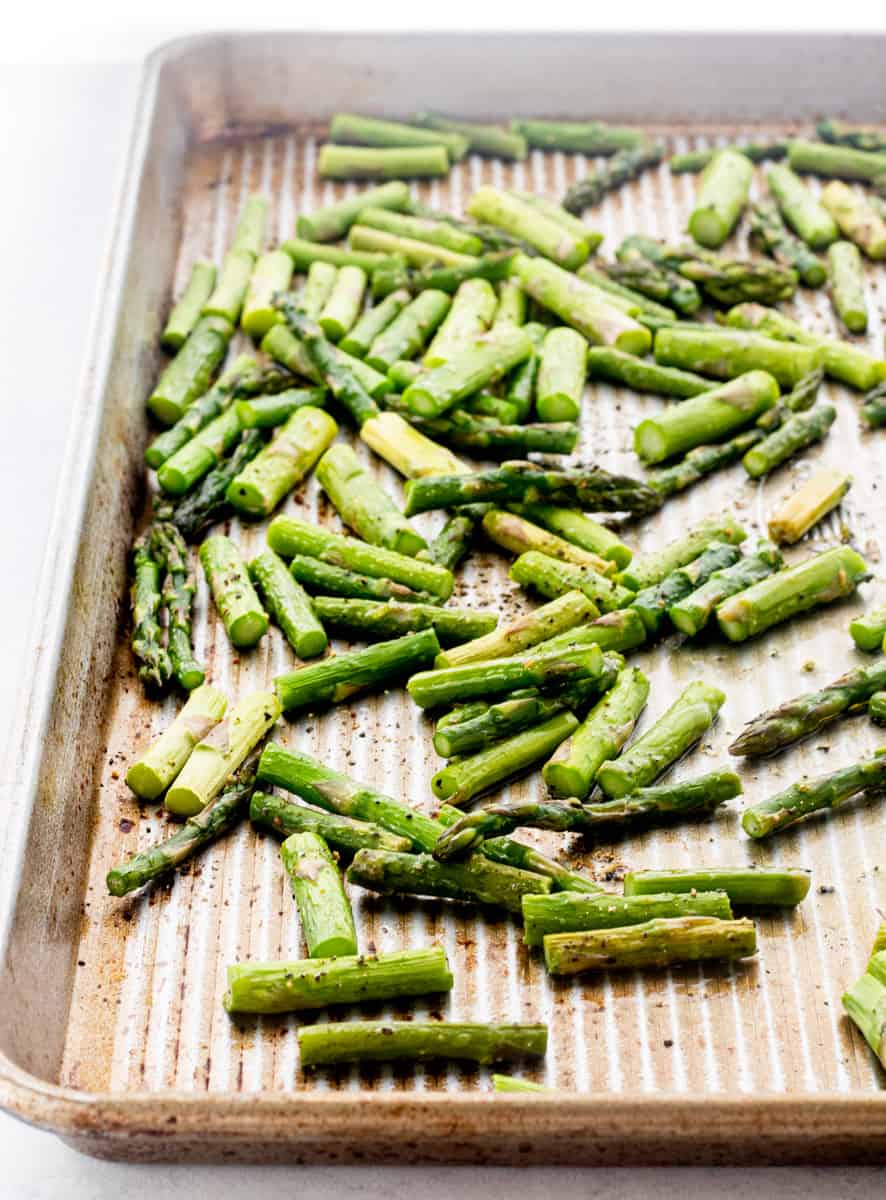
Add the couscous to a small sauce pan along with the broth and some olive oil. Bring to a boil, reduce heat and allow it to simmer until cooked, about 8-10 minutes.
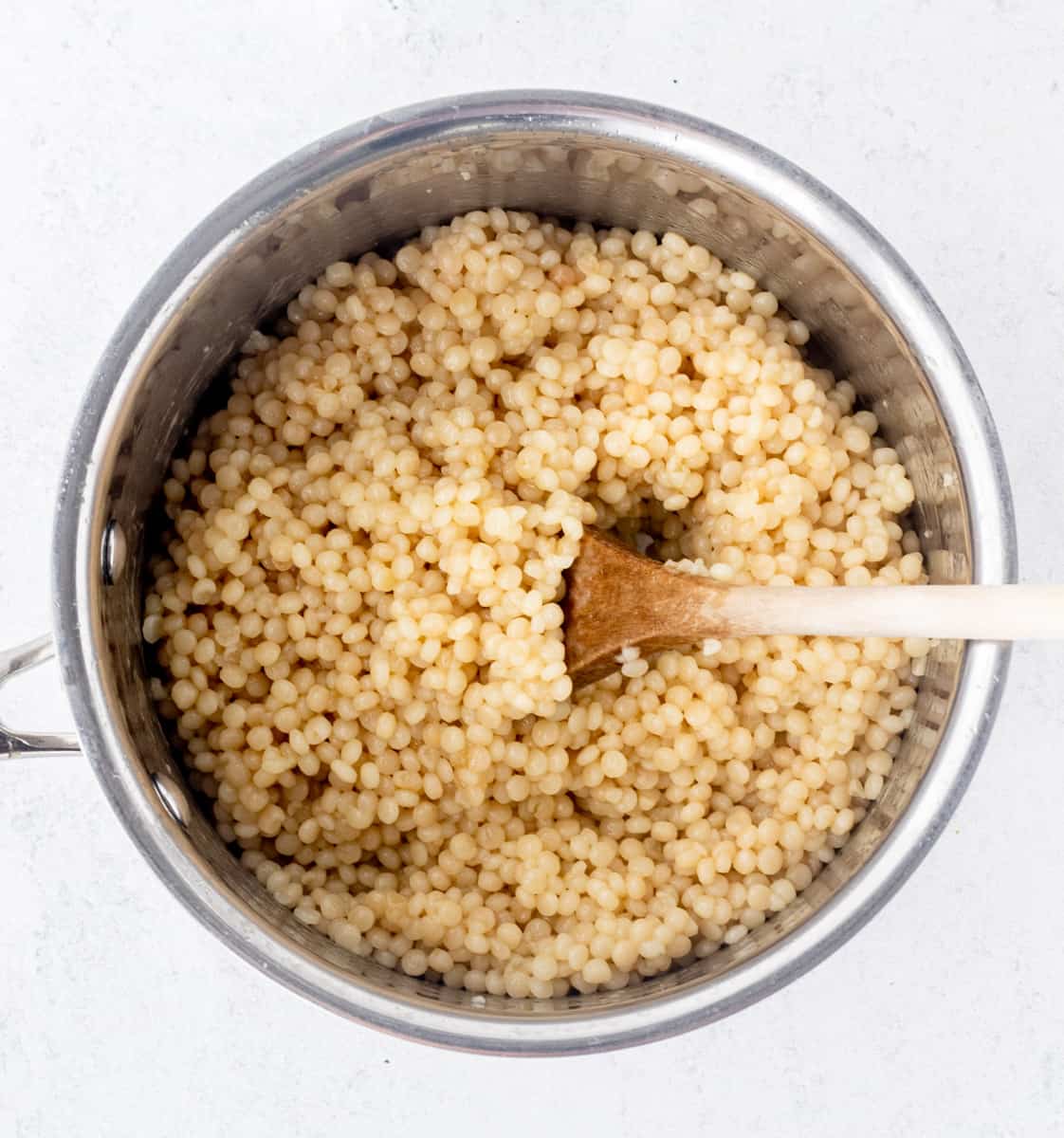
Meanwhile, prepare the dressing in a small bowl or jar. This dressing recipe makes more than you’ll probably need.
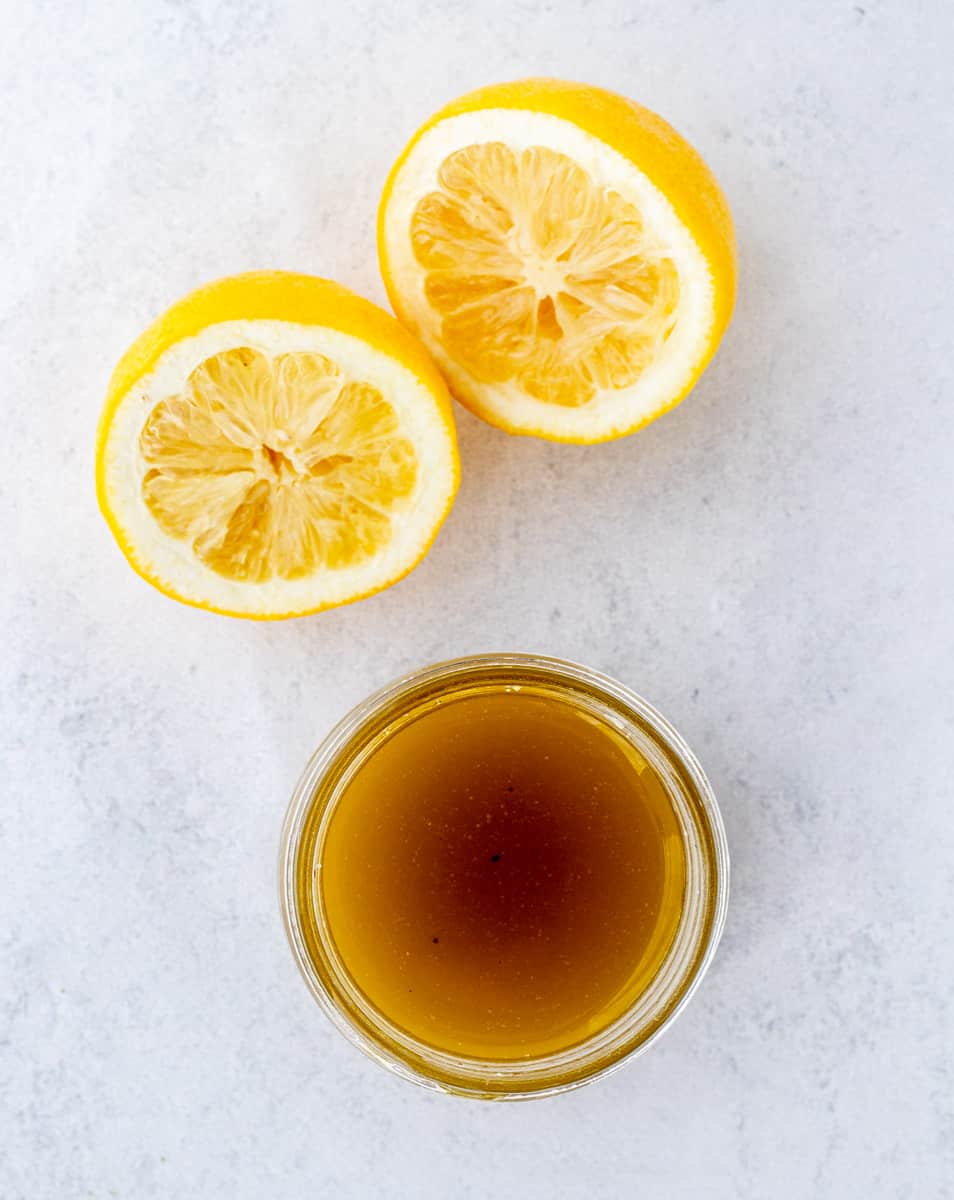
Grab a large bowl and toss together the cooked couscous, asparagus, feta, chickpeas and sun-dried tomatoes (if using).
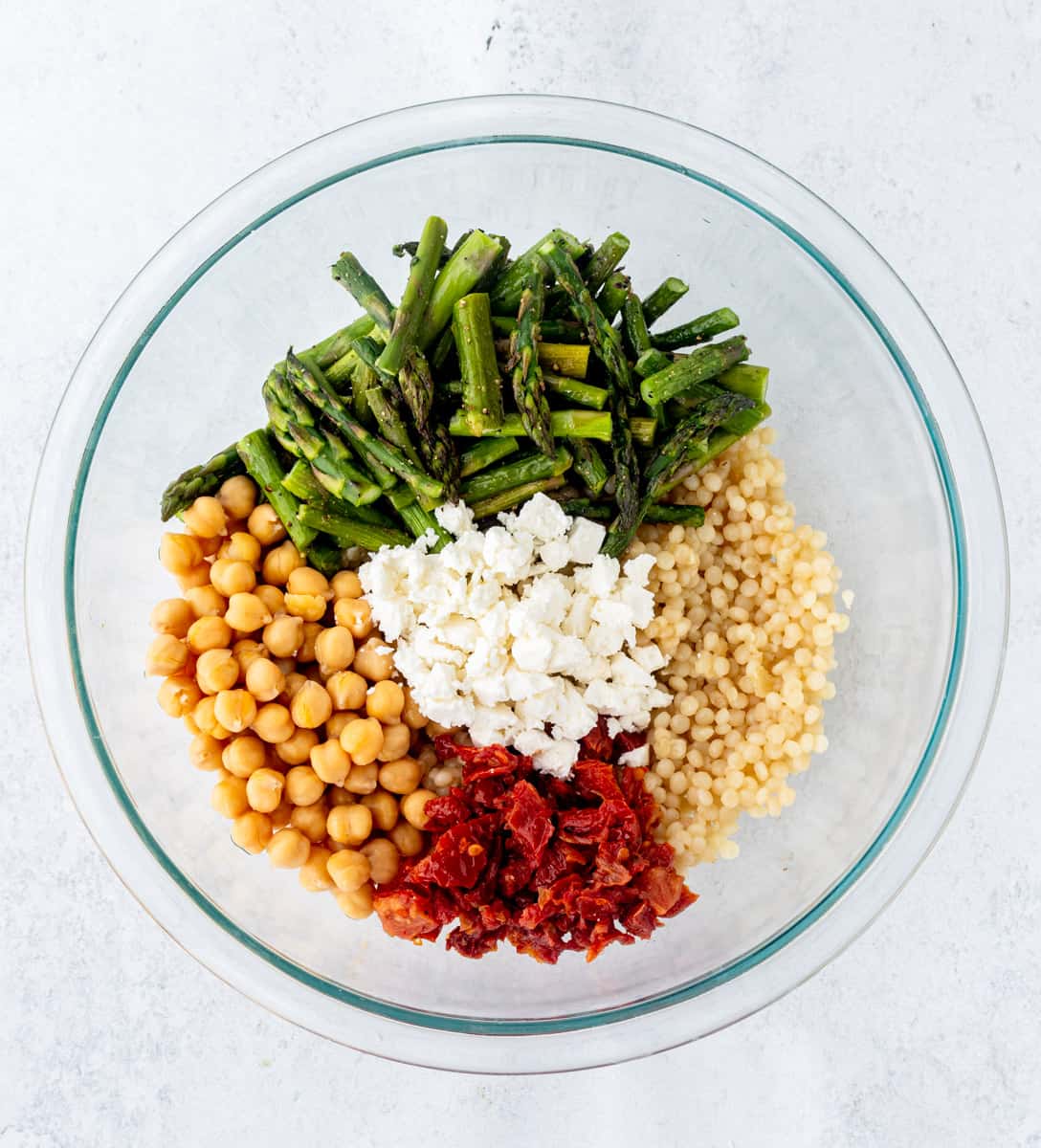
Pour in desired amount of dressing (I used about half).

Place in the fridge for at least half an hour to allow those flavours come together.
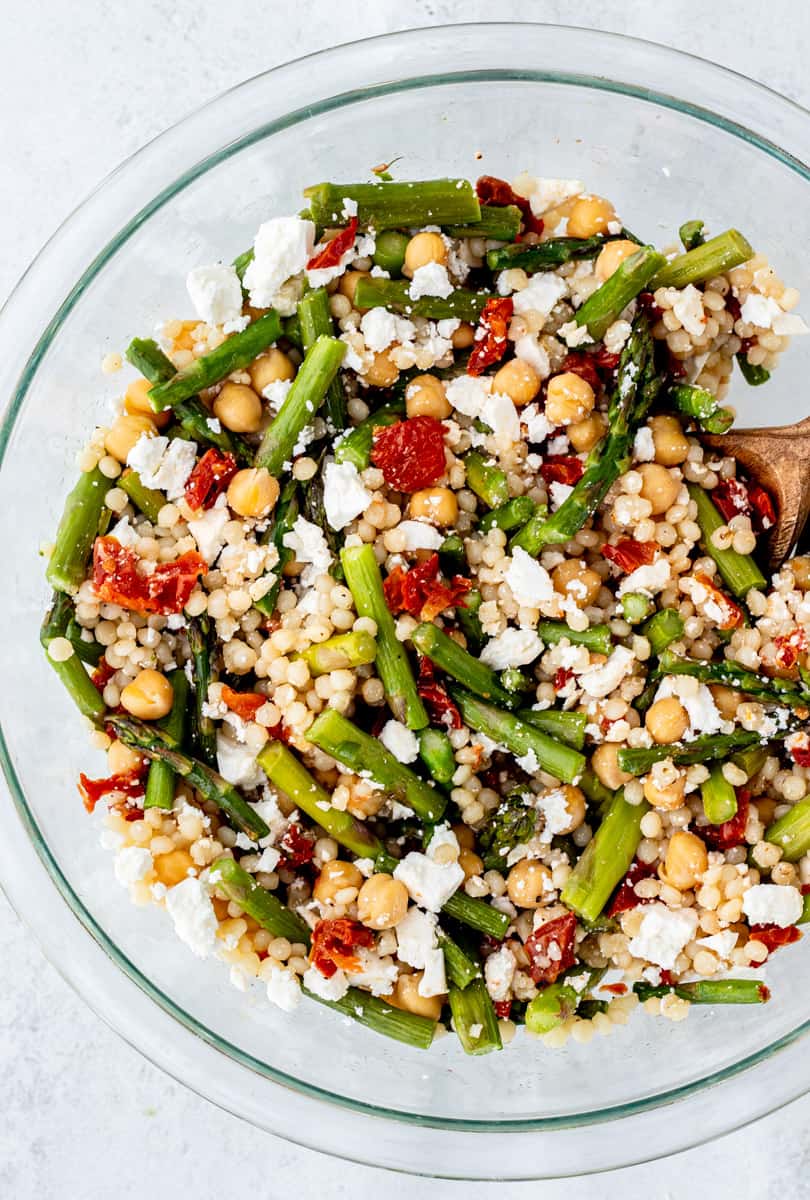
Recipe Tips:
- I recommend using asparagus that’s medium size in thickness. I find if it’s too thin, it almost gets too stringy and chewy when roasted.
- Cook the Israeli couscous in reduced sodium broth to infuse some extra flavour into it while it’s cooking. You can use vegetable or chicken broth — it’s totally up to you.
- Don’t skip the step where you add the olive oil to the couscous while it’s cooking. Israeli couscous tends to get fairly sticky once cooked so the addition of the olive oil can help prevent it from sticking together.
- Be sure to watch the couscous closely while it’s cooking. It tends to cook fairly fast (about 8-10 minutes), so you’ll want to make sure that you check it so it doesn’t stick to the bottom of the pan. It should have an al dente texture.
- The recipe for the lemon dressing makes more than you’ll probably need. I only used half of the dressing for one batch of this salad. When I make dressing, I always like to make extra because that way I can use it on other salads or make the same salad the next week as well! Saves the trouble of having the make the dressing again.
- I have discovered the best lemon juicer EVER. I love to make lemon-infused recipes so this thing is definitely coming in handy. Everyone NEEDS one of these juicers in their life!
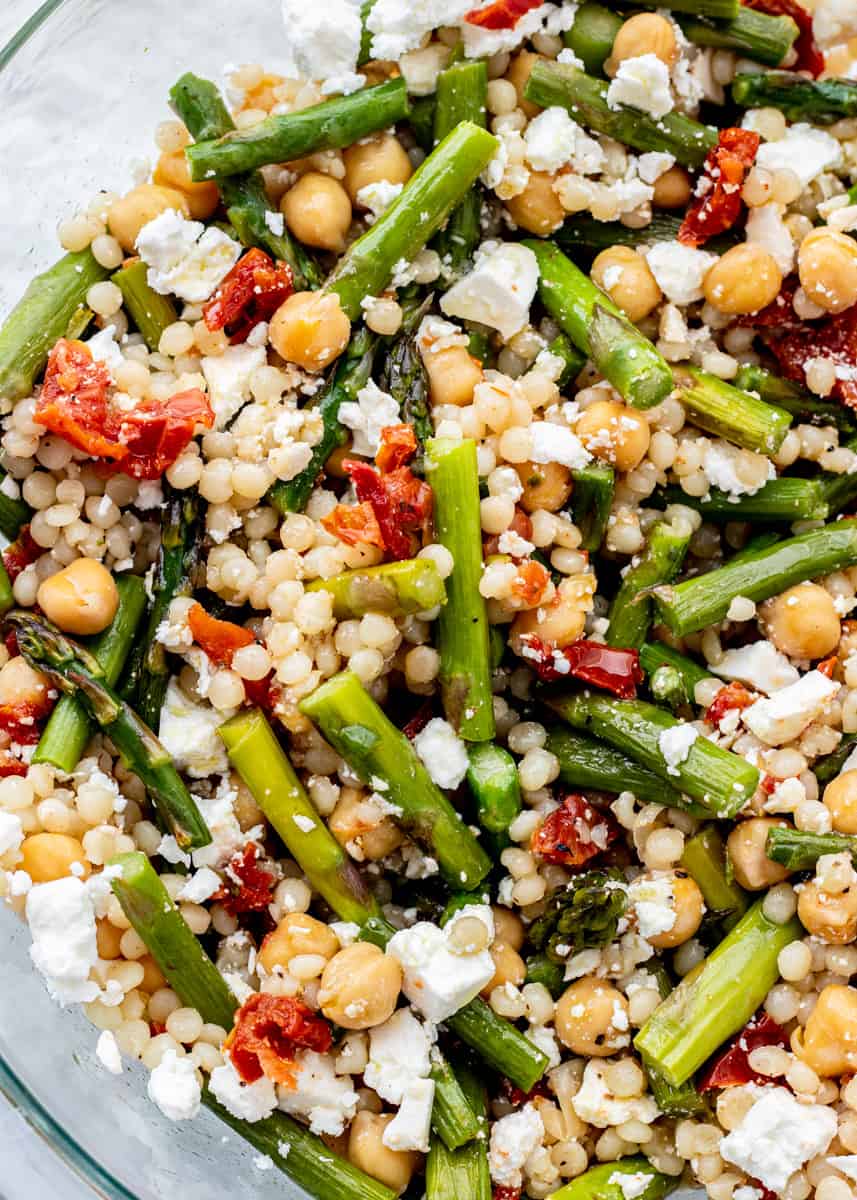
Recipe FAQs
How do I know when the roasted asparagus is done?
The amount of cooking time will depend on the thickness of the asparagus. The thicker the asparagus, the more time it will need. The asparagus should be slightly tender but still crisp.
Is couscous pasta?
Couscous is similar to pasta. It’s made from crushed durum wheat semolina, whereas pasta is made from ground wheat. Pasta and couscous have a similar nutritional value. It’s not technically a grain, but it’s made from them.
What is the difference between couscous and Israeli couscous?
Both are made with the same ingredients, but couscous is much smaller with an irregular shape. Israeli couscous forms smooth round balls similar to the size of a peppercorn rather than flakes.
What does Israeli couscous taste like?
It has a soft and chewy texture and a slight nutty flavour. It’s quite similar to barley with a neutral savoury flavour that’s perfect to use as a base for salads or to incorporate into soups.
How to Store
The beauty of this couscous salad is that it lasts in the fridge for a few days, which means that it’s great for meal prepping.
I recommend keeping it in the fridge covered in a bowl or air-tight container for up to four days.
I actually find that it tastes better as the days go on because the couscous, chickpeas and asparagus absorb all of those amazing flavours from the lemon dressing and feta.
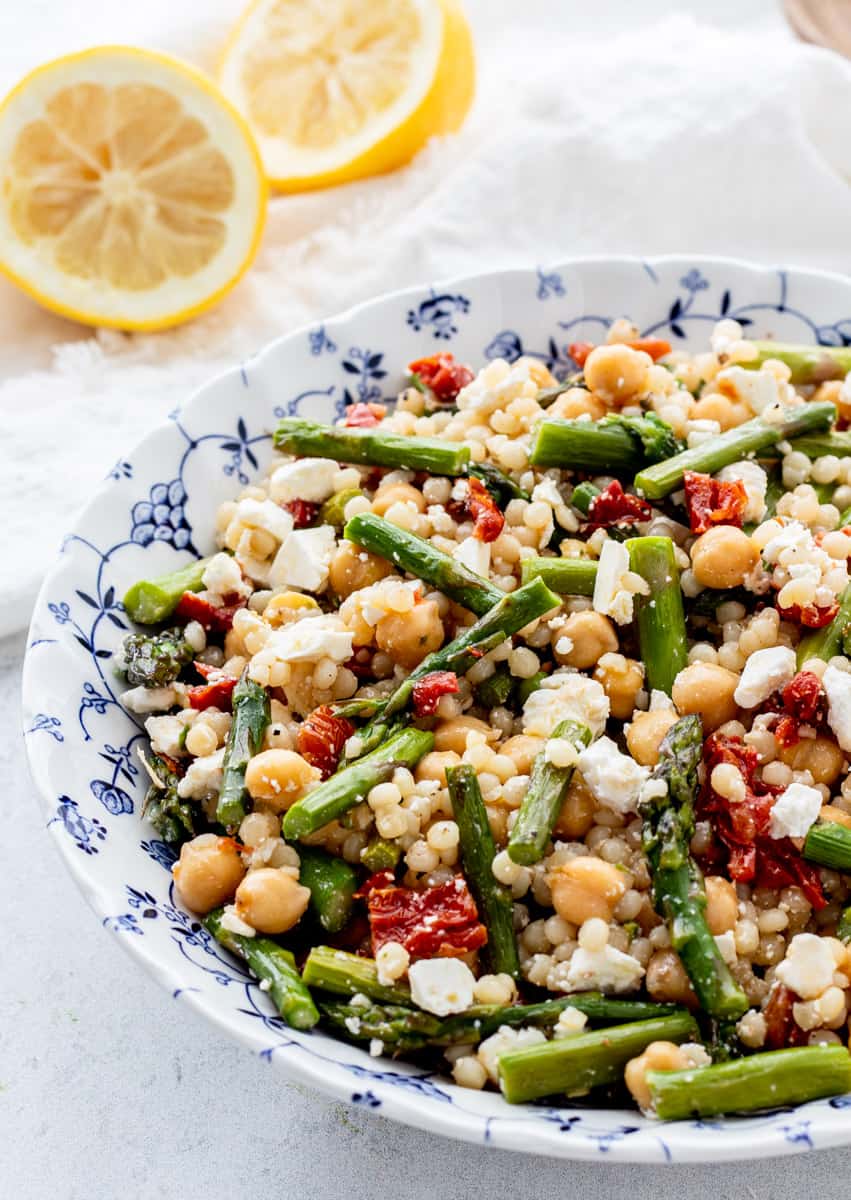
Serving suggestions
This pearl couscous salad is great served as a side dish or main.
You can serve it along with:
- Grilled lemon garlic chicken kabobs
- Walnut crusted salmon
- Almond coconut crusted fish sticks
- Zesty zucchini turkey burgers
- Or on its own for a vegetarian option!
Recipe variations
This pearl couscous salad is delicious as it is, but you can easily adapt it to suit your own tastes:
- To add more protein – Add grilled chicken breast
- To make it vegan – Skip the feta cheese and sub in maple syrup for honey in the dressing
- Vegetables – Instead of the sun-dried tomatoes, you could use cherry tomatoes or roasted red pepper. You could also toss in extra vegetables like cucumbers or zucchini.
- Different grains – You could also try regular couscous, quinoa, farro, or rotini pasta instead of the Israeli couscous to switch it up
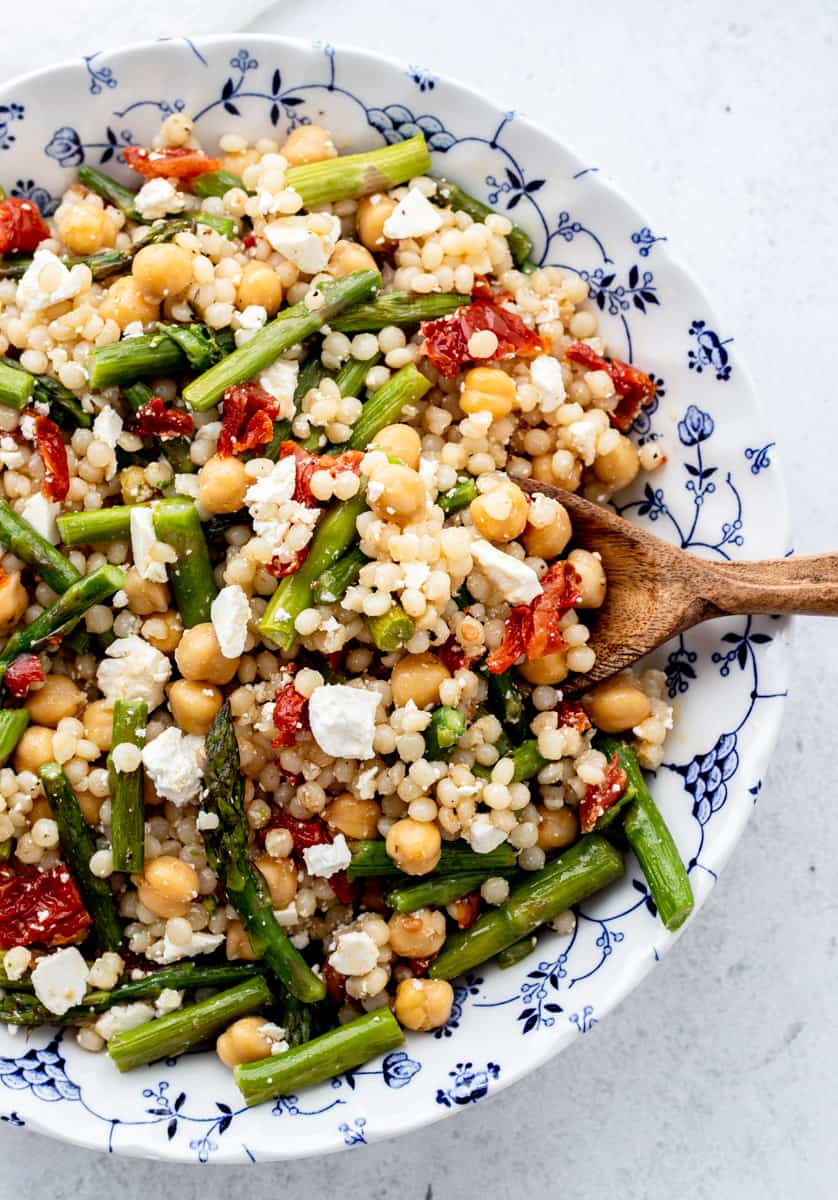
More Delicious Side Dishes
- One Pan Feta Pasta with Cherry Tomatoes
- Mediterranean Chickpea Salad
- Avocado Chickpea Salad
- Greek Cucumber Noodle Salad
- No-Mayo Broccoli Apple Salad
- Greek Quinoa Salad
- Blueberry Walnut Salad with Lemon Dressing
- Roasted Asparagus Spring Salad
Did you make this recipe? Scroll down to leave a rating and review!
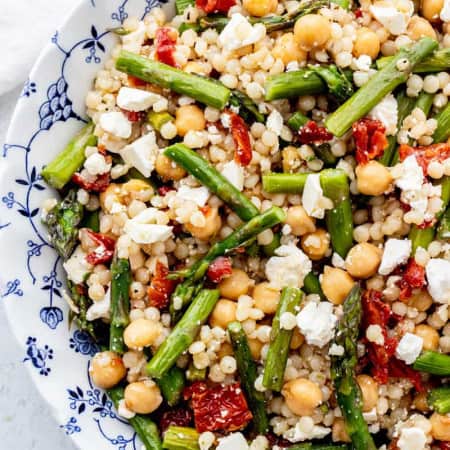
Pearl Couscous Salad with Roasted Asparagus and Chickpeas
Ingredients
For the salad:
- 1 lb asparagus chopped into 1-inch pieces
- 1 cup uncooked Israeli couscous
- 1 1/4 cup no salt added broth can use chicken or vegetable broth
- 2 tbsp. olive oil divided
- 3/4 cup crumbled feta cheese
- 1 cup cooked or canned no salt-added chickpeas
- 1/3 cup finely chopped sun-dried tomatoes (optional)
Instructions
- Preheat oven to 375 degrees F. Place asparagus on a baking sheet and drizzle with one tablespoon of olive oil, and a sprinkle of salt and pepper. Toss asparagus until evenly coated. Roast asparagus for 10-15 minutes, until tender but still crisp. If it's extra thick, it may require more time.
- Meanwhile, place the couscous, broth and one tablespoon of olive oil in a small sauce pan and bring to a boil. Cover, reduce heat to low and simmer for 8-10 minutes or until couscous is fluffy. It should have an "al dente" texture when done. Once cooked, fluff with fork and allow to cool.
- While the asparagus and couscous are cooking, mix all of the ingredients for the dressing in a small bowl or jar.
- Add the cooked couscous, roasted asparagus, feta cheese, chickpeas, and sun-dried tomatoes (if using) to a large bowl. Add in desired amount of dressing (I only used half).
- Place in the fridge for at least half an hour to allow flavours to absorb.
Notes
- The nutritional information is based on using all of the dressing. If you choose to use less, the nutritional facts will be different.
- I recommend using asparagus that’s medium size in thickness. I find if it’s too thin, it almost gets too stringy and chewy when roasted.
- Cook the Israeli couscous in reduced sodium broth to infuse some extra flavour into it while it’s cooking. You can use vegetable or chicken broth — it’s totally up to you.
- Don’t skip the step where you add the olive oil to the couscous while it’s cooking. Israeli couscous tends to get fairly sticky once cooked so the addition of the olive oil can help prevent it from sticking together.
- Be sure to watch the couscous closely while it’s cooking. It tends to cook fairly fast (about 8-10 minutes), so you’ll want to make sure that you check it so it doesn’t stick to the bottom of the pan. It should have an al dente texture.
- The recipe for the lemon dressing makes more than you’ll probably need. I only used half of the dressing for one batch of this salad. When I make dressing, I always like to make extra because that way I can use it on other salads or make the same salad the next week as well! Saves the trouble of having the make the dressing again.
- I have discovered the best lemon juicer EVER. I love to make lemon-infused recipes so this thing is definitely coming in handy. Everyone NEEDS one of these juicers in their life!
Nutrition
This recipe was originally posted in May 2019 and was updated to include better tips and photos in March 2021.

















I couldn’t believe how delicious and flavorful this dish was! My family loved it as well.
So glad you and your family enjoyed the recipe! It’s always a favourite around our house as well :) Thanks for returning to leave a review!
Loved this recipe, thank you so much! Hubby and I had it on a bed of rocket. How big is the portion size @ 470 calories?
So happy you and your husband enjoyed the recipe! Love how you served it on rocket! The calorie count would be for about a 1 cup serving or 1/6th of the salad. That number was calculated based on using all of the dressing. I generally only use half the dressing on the salad, so in that case, the nutritional information would be different and the calorie count would be lower. It really depends on how much dressing you choose to use, so that nutritional information is only a rough estimate. Hope that helps!